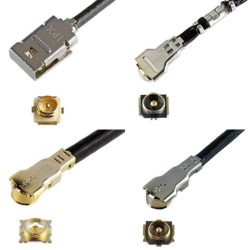Wi-Fi 6 Eases the Wireless Connectivity Traffic Jam
New technologies make this latest protocol more efficient by addressing reliability, lower latency, greater throughput, battery life, and security.

Wi-Fi 6 (802.11ax), released in 2019, is the latest wireless standard currently available. While it is faster than its predecessors, Wi-Fi 5 (802.11ac) and Wi-Fi 4 (802.11n), the main concern during its development was not actually increasing speed, but rather how to improve the performance of a Wi-Fi network that has many devices connected to it. Anyone who has had difficulty connecting to Wi-Fi in an area crowded with devices trying to do the same, such as in a busy hotel or office building, can understand this frustration. The issue became painfully apparent during the height of the Covid pandemic when multiple family members working and going to school from home all needed to be connected during the day. “There’s too much interference and only a few channels that are available. The system is supposed to frequency hop to optimize the network, but it doesn’t always work,” said Travis Amrine, global industry marketing manager with I-PEX.
While Covid has largely resolved, the issue of device density continues. Today’s smart homes and businesses are being equipped with an increasing number of devices all vying for access to the same limited bandwidth. Developments like data heavy streaming services and the increasing number of wirelessly connected devices contribute to the frequency congestion, Amrine added.
Fortunately, Wi-Fi 6 has several notable improvements over earlier protocols, speed among them. With a maximum speed of 9.6 Gb/s, it is more than twice as fast as the 3.5 Gb/s maximum speed of Wi-Fi 5. Keep in mind that this refers to the speed of the LAN (local area network), not the internet, and it is shared by all the devices on the network so each device will not necessarily achieve that speed. Still, the efficiency garnered from the new technology in Wi-Fi 6 can make it seem faster by keeping the network from bogging down.
What Makes Wi-Fi 6 Better?
Several new technologies make Wi-Fi 6 more efficient by addressing reliability, lower latency, greater throughput, battery life, and security.
OFDMA (orthogonal frequency-division multiple access) lowers latency. With Wi-Fi 5, data transmissions could only deliver one piece of data to one device at a time. With multiple connected devices, each would have to wait its turn to receive that data. OFDMA allocates bandwidth to accommodate multiple users at the same time. The result is reduced lag through more efficient data delivery.
MU-MIMO (multiple-user, multiple-input, multiple-output) technology allows multiple devices to communicate with a Wi-Fi router at the same time. (Wi-Fi 4 has SU-MIMO, single-user MIMO, that allowed communication with multiple devices, but only one at a time.) MU-MIMO first appeared in Wi-Fi 5 version 2. At that time, it was just for download and could only support four simultaneous data streams. The Wi-Fi 6 version has improved in two significant ways. It now applies to upload as well as download and it supports 12 streams. MU-MIMO divides the internet bandwidth into streams that are directed to each of the connected devices. This results in faster speeds that are particularly noticeable for activities that require a lot of bandwidth such as streaming video or downloading.
Beamforming technology strengthens the signal by sending the transmissions in a specific direction (toward each device) rather than in every direction, as was the case in older routers.
BSS (basic service set) coloring minimizes interference from other networks that are in proximity. It colors, or marks, the frames so it can distinguish them from the ones on its own network and disregard them. BSS coloring boosts efficiency because the router stays focused on the correct network, making it more responsive.
Target Wake Time (TWT) is a feature in Wi-Fi 6 that extends battery life by using energy more efficiently. TWT schedules when a Wi-Fi 6 client will wake up and when it will go to sleep. “Inside every wireless device, whether it’s Wi-Fi, or cellular, or Bluetooth, there’s a radio. The radio is what actually sends out the Wi-Fi, cellular, or Bluetooth signals,” said Danny Walters, product marketing specialist for wireless products at Phoenix Contact. “Many wireless devices have that radio on all the time, so they are always ready to communicate. That can use up a lot of power. With TWT, the Wi-Fi 6 client does not have to keep its Wi-Fi radio powered continuously. It’s able to say, ‘Hey, I know that every day at this time I’m going to power on and send out a little bit of data.’ Maybe the Wi-Fi device is connected to a level sensor on a water tank and it knows that it will wake up and transmit the value of the water level in the tank every day at 12 o’clock, and then go back to sleep. Only having the radio powered on at very specific times throughout the day makes the Wi-Fi clients or Wi-Fi end devices more energy-efficient and drastically decreases the amount of energy that’s drawn from the battery. That directly leads to an increase in battery life.” A processor on board will use a small amount of battery power during this super low-power sleep mode to keep track of the time, so the device knows when to wake itself up. The device can be on, even if the radio is not powered on.
WPA3 is the latest security protocol. It provides better encryption, more robust authentication, and improved protection against password guessing. To be Wi-Fi 6 certified, a device must have WPA3.
Wi-Fi 6e. The “e” stands for ‘extended’ because Wi-Fi 6e extends the capabilities of Wi-Fi 6 to the 6 GHz band, which opens up more channels with greater efficiency. “This band has way more channels than the 2.4 GHz and 5 GHz bands and is nearly empty,” said Walters.
To upgrade or not to upgrade
“I would say the biggest improvement with Wi-Fi 6 is the overall efficiency of how Wi-Fi operates. However, that is a function of how it works with Wi-Fi 6 devices. Older Wi-Fi devices cannot take advantage of the Wi-Fi 6 efficiency enhancements. These efficiency enhancements are limited to Wi-Fi 6/6e devices because they are the only ones that are compatible with these new features. Older Wi-Fi devices simply do not understand the new Wi-Fi communication methods,” Walters added. “While the greatest benefits are realized with Wi-Fi 6 devices, depending on a company’s device upgrade cycle and budget constraints, it may make sense to upgrade the access points to Wi-Fi 6 even if older Wi-Fi end devices are still in use. That way, you are ready to take advantage of the Wi-Fi 6 enhancements when older devices are replaced with Wi-Fi 6 devices.”
Another reason to upgrade is the impact on the environment. A report that WIK-Consult prepared for the Wi-Fi Alliance, the worldwide network of companies that develops Wi-Fi technologies, requirements, and test programs, found that opening Wi-Fi access to the entire frequency band offers significant reductions in energy consumption and environmental footprint. This advances environmental sustainability goals for combatting climate change.
New Opportunities for Connectors and Connector Companies
“We’re starting to see some spaces going from MHF 1, which is 20-year-old technology, to MHF 4L, which is 10-year old technology, because it’s smaller and more dense, and has a slightly better range of frequencies that it can operate in. There is talk of even higher provisioning for higher frequencies for future Wi-Fi generations, in double digits,” said Amrine. “MHF 7S, our latest technology, incorporates even better EMI performance because more antennas spaced closer to together means more EMI generated within the device.”

As Wi-Fi technology advances, I-PEX continues to advance its own RF connector product line. (Clockwise from top left): MHF 1 LK, MHF 4, MHF 5L, MHF 7S.
The advancements brought about with Wi-Fi 6 will allow more devices to use Wi-Fi. “We may see companies producing more AR and VR devices, for example, as it becomes more feasible for them to use Wi-Fi 6. We will likely see more devices that can take advantage of the TWT technology to save power, such as sensors that will need wireless communication,” said Walters. With Wi-Fi 7 in development, this market is only going to grow.
To learn more about the companies mentioned in this article, visit the Preferred Supplier pages for Phoenix Contact and I-PEX.
Like this article? Check out our other Wireless, Smart Devices, our Datacom Market Page, and our 2023 Article Archive.
Subscribe to our weekly e-newsletters, follow us on LinkedIn, Twitter, and Facebook, and check out our eBook archives for more applicable, expert-informed connectivity content.
- Sealing Success: Overmolding for More Secure Connections - April 23, 2024
- Medical Cable Assemblies Product Roundup - April 23, 2024
- Mezzanine Connectors Product Roundup - April 16, 2024





